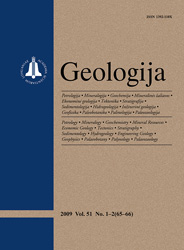Geologija / Geology
WHAT?
 ISSN 1392-110X ISSN 2029-056X (online) |
2008 m. Nr. 2 The first large geological map of Central and Eastern Europe (1815)
The first large geological map of Central and Eastern Europe was compiled by Stanisław Staszic in the early 19th century. The map is based on the geological survey that Staszic performed in different parts of Poland and adjacent areas. In 1814, Staszic presented his ideas on the geology and mineral sources of Poland and Lithuania. In 1815, he completed the book-length descriptive analysis O ziemorodztwie Karpatów i innych gór i równin Polski przez Stanisława Staszica, which was published in Warsaw and complemented by a large geological map of Central and Eastern Europe. His later studies were compiled in a historico-philosophical treatise titled Ród ludzki (1819–1820). The complete edition of Staszic’s works, Dzieła, which also included these publications, appeared over 1816–1820. The geological field survey that he performed over several years, and his study of social-economic problems enabled Staszic to draw in great detail a geological map of the Carpathians, the Central Polish Highlands, Volhynia (modern Ukraine) and the Eastern Alps, as well as the areas of the Polish–Lithuanian Lowlands, the southern coast of the Baltic Sea, Polesye (modern Belarus), Moldova, Transylvania, and Hungary. Staszic was interested in the exploration of mineral deposits, particularly in Poland, which had rock salt, copper and iron ores, and coal. In his monograph and map, he adopted a stratigraphic subdivision based on types of rock contents and organic fossils, which was a slightly modified version of Werner’s classification system. The lithological legend sets five classes and 135 different types of rock, and 15 types of ore deposits, using the French names for these. In general, Staszic was an advocate of Werner’s paradigm; however, he did not follow exactly the ideas of the German geologist. Staszic’s fundamental work recapitulates his views on geological history of Central and Eastern Europe, and brings to an end the Enlightment period in the geology of that part of Europe. Keywords: Stanisław Staszic, geological cartography, Central and Eastern Europe |
Issues:
2011 - Vol.53 No. 1, No. 2, No. 3 2010 - Vol.52 No. 1-4 2009 - Vol.51 No. 1-2, No. 3-4 2008 - Vol.50 No. 1, No. 2, No. 3, No. 4, No. Priedas 2007 No. 1, No. 2, No. 3, No. 4 2006 No. 1, No. 2, No. 3, No. 4 2005 No. 1, No. 2, No. 3, No. 4 2004 No. 1, No. 2, No. 3, No. 4 2003 No. 1, No. 2, No. 3, No. 4 2002 No. 1, No. 2, No. 3, No. 4 2001 No. 1, No. 2, No. 3, No. 4 |